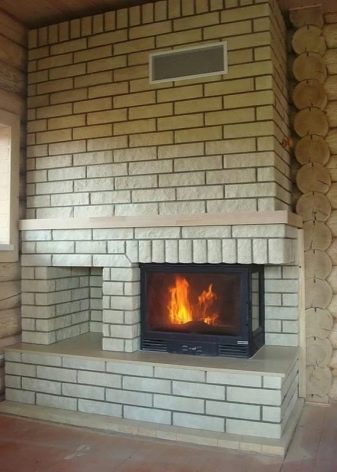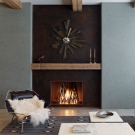Facing stoves and fireplaces
Installing a fireplace in the house is half the battle. The second half is to make a beautiful lining. Of course, if you are constructing a wood-burning fireplace, putting it out of brick in the country, it is not at all necessary to revet it, and so it looks good. But if you want to make the fireplace part of the interior in a different style, then you have to do it trim.
Types of cladding
Brick. Yes, brick can also become part of the furnace lining. We are talking about facing bricks. A great advantage of facing bricks over other materials is the absence of cracks during heating. In addition, the lining can be carried out in parallel with the laying of the fireplace, for this is not used an additional grid.
If the finishing of a metal furnace is required, then a space is left between the facing brick and the furnace, which is filled with sand of small fractions. This will not allow the brick to crack and will transfer energy well.
Tile. If you use ordinary ceramic tiles, it is better for facing fireplaces, not stoves. The tile has limitations on the surface heating temperature: since it is not interconnected by locks, it cannot withstand the furnace deformation from heating.
Fake diamond. It has a small weight, which facilitates its installation, has a huge number of drawings and textures. An excellent choice for finishing apartment electrofireplace, as it is easy to fit not only on a metal surface, but also on a structure made of wood or chipboard, a stone is fixed to the glue recommended by the manufacturer.
Material properties
Any lining material must have certain properties: to be refractory and not to provoke fire hazardous situations, to be durable, to withstand an infinite number of heating and cooling cycles, to be environmentally friendly and not to emit harmful substances when heated, to easily wash, to improve the efficiency of the fireplace or stove (or extreme cases do not worsen).
Clinker tiles - a popular material for lining. It is relatively cheap, it allows stacking layers at a sufficiently large distance from each other (4 mm).For lining the stove you need a clinker with a thickness of 8 mm, for fireplaces 6 mm. The disadvantage of the material is to reduce the efficiency of the furnace. Therefore, clinker is best to get off fireplaces, to which there are not so high requirements for space heating.
Terracotta - heat-resistant tile, consisting of several components: fireclay, pottery clay and mineral additives. It is of higher quality than clinker and can be quite large in size - a 40x40cm square. Another advantage of terracotta is its good adhesion to the surface with glue or a mixture. It is often used to implement some design ideas. The terracotta tiles are given the most varied texture, and the kiln lined with it adds an efficiency of 3-4pp.
Majolica - this is the same terracotta, only having a glazed front part. This is a salvation for those who want to decorate a fireplace or stove in accordance with the Scandinavian design of the room - matte majolica fits best with wood.
Tile - a special tile for facing furnaces, which is fully protected from deformation and can withstand a huge number of heating-cooling cycles.From the back side it has rumpa - special protrusions for which the tiles are interconnected and which are pressed into the solution. Technology laying a kind of tile. First, they are fastened together by brackets and wire antennae, tillers are poured with clay, installed on the stove, and then the main kiln wall is laid out.
Choice of design
If you need a “primeval” design of the hearth, but its heating and cooking properties are not important, then you can look at natural stone, porcelain stoneware. For stoves with cast-iron firebox, which will be used for cooking and heating, the stone will not work - low thermal conductivity. The oven, beautifully lined with labradorite, will begin to give off heat in about an hour or two after the hot duck. But the fireplace, on the contrary, can win when finishing with a stone: since it is already not very willing to give up heat to the room, additional heating of the stones will increase its efficiency.
Selecting a natural stone in the design, it is necessary to take into account the fact that most rocks have a rapid loss of water from the composition. This leads to a violation of the structure of the stone and the deterioration of its appearance.Therefore, natural granite, basalt and other rocks are not well suited for cladding. And granite, in addition, has a radiation background higher than that of other rocks. From natural stones it is better to stop on a shell rock, sandstones, marble, feldspar.
If you really want a fireplace under the "granite", then for a niche or front panel is better to choose the porcelain. It consists of feldspar, clay, kaolin and quartz sand, which is baked at a temperature of 1300 degrees. The main property of this material is resistance to high temperatures and changes in humidity; it does not crack and does not lose its original appearance. This allows you to coat them with fireplaces and stoves, even in unheated premises, for example, in the country.
Do-it-yourself finishing steps
After you have chosen the material for finishing, you can proceed directly to the lining.
- Cleaning the coated surface. Scraping rust, if it appeared, leveling, degreasing.
- If you put a facing stone or tile, around the fireplace walls, you need to tighten the reinforced mesh and fix it with glue or glue mixture, spreading it according to the instructions for this particular stage of work.
- The tile should lie flat, so use a plumb line for the vertical and level for the horizontal line to apply the markings of the rows.
- If you put an artificial stone, then you need to start laying from top to bottom, if the tile, then the first row should be at the bottom. Each type of tile is placed on the appropriate adhesive composition for it. For tiling tiles, you can use a rubber mallet.
- Between the tiles, install plastic crosses to ensure smooth gaps. Remove the glue on the surface of the tile immediately, otherwise it will harden and spoil the lining.
- Do not rub the seams immediately. This can be done only after a day. After that, the tiles need to be cleaned from dust. If the surface is porous, wipe with a rag.




























































